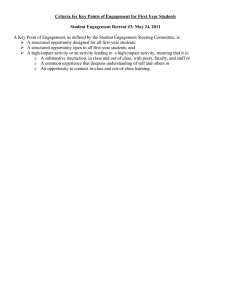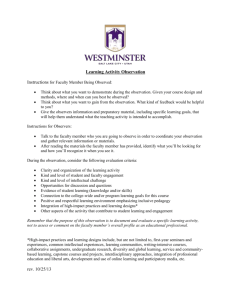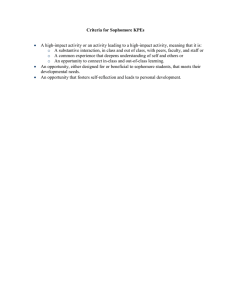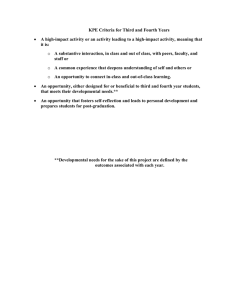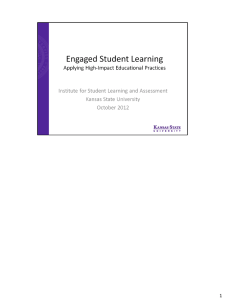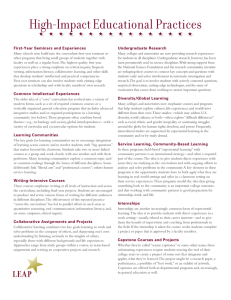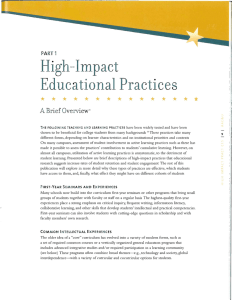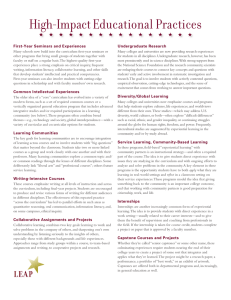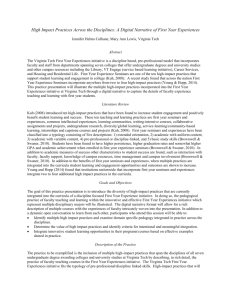Document 13099736
advertisement
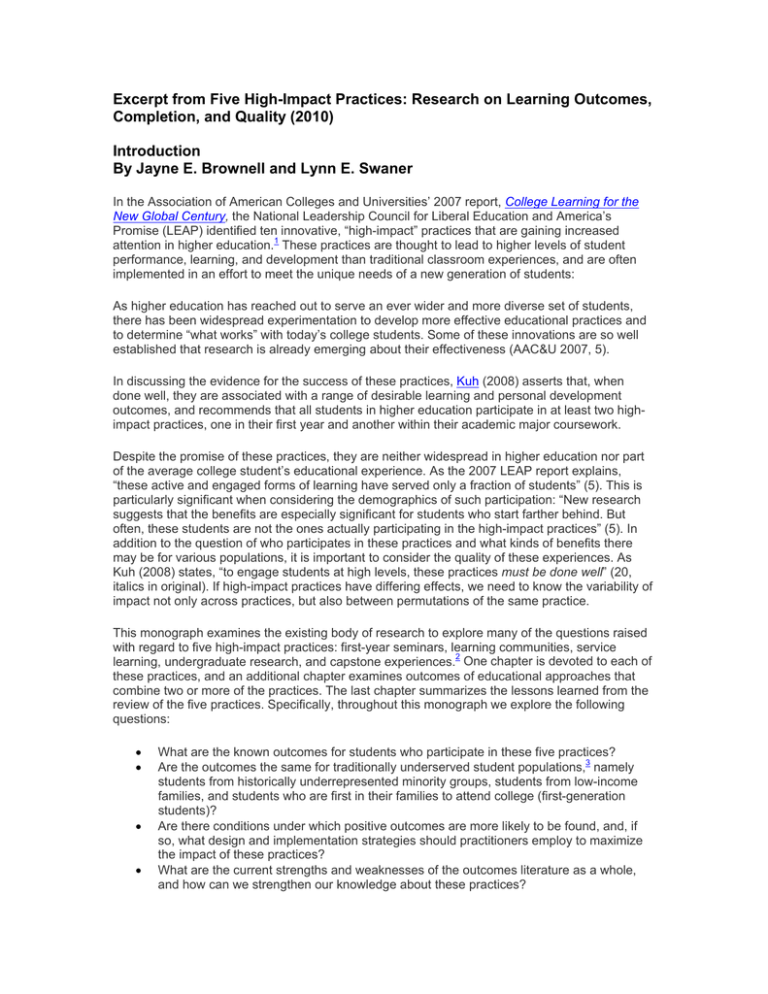
Excerpt from Five High-Impact Practices: Research on Learning Outcomes, Completion, and Quality (2010) Introduction By Jayne E. Brownell and Lynn E. Swaner In the Association of American Colleges and Universities’ 2007 report, College Learning for the New Global Century, the National Leadership Council for Liberal Education and America’s Promise (LEAP) identified ten innovative, “high-impact” practices that are gaining increased attention in higher education.1 These practices are thought to lead to higher levels of student performance, learning, and development than traditional classroom experiences, and are often implemented in an effort to meet the unique needs of a new generation of students: As higher education has reached out to serve an ever wider and more diverse set of students, there has been widespread experimentation to develop more effective educational practices and to determine “what works” with today’s college students. Some of these innovations are so well established that research is already emerging about their effectiveness (AAC&U 2007, 5). In discussing the evidence for the success of these practices, Kuh (2008) asserts that, when done well, they are associated with a range of desirable learning and personal development outcomes, and recommends that all students in higher education participate in at least two highimpact practices, one in their first year and another within their academic major coursework. Despite the promise of these practices, they are neither widespread in higher education nor part of the average college student’s educational experience. As the 2007 LEAP report explains, “these active and engaged forms of learning have served only a fraction of students” (5). This is particularly significant when considering the demographics of such participation: “New research suggests that the benefits are especially significant for students who start farther behind. But often, these students are not the ones actually participating in the high-impact practices” (5). In addition to the question of who participates in these practices and what kinds of benefits there may be for various populations, it is important to consider the quality of these experiences. As Kuh (2008) states, “to engage students at high levels, these practices must be done well” (20, italics in original). If high-impact practices have differing effects, we need to know the variability of impact not only across practices, but also between permutations of the same practice. This monograph examines the existing body of research to explore many of the questions raised with regard to five high-impact practices: first-year seminars, learning communities, service learning, undergraduate research, and capstone experiences.2 One chapter is devoted to each of these practices, and an additional chapter examines outcomes of educational approaches that combine two or more of the practices. The last chapter summarizes the lessons learned from the review of the five practices. Specifically, throughout this monograph we explore the following questions: What are the known outcomes for students who participate in these five practices? Are the outcomes the same for traditionally underserved student populations,3 namely students from historically underrepresented minority groups, students from low-income families, and students who are first in their families to attend college (first-generation students)? Are there conditions under which positive outcomes are more likely to be found, and, if so, what design and implementation strategies should practitioners employ to maximize the impact of these practices? What are the current strengths and weaknesses of the outcomes literature as a whole, and how can we strengthen our knowledge about these practices? If we are to create what Leskes and Miller (2006) have called “purposeful pathways” for student learning, practitioners and researchers need a better understanding about the variation among and within these practices, and which variables are likely to lead to the most positive outcomes for our students and our institutions. 1. The high-impact practices indentified in the report are: first-year seminars, common intellectual experiences, learning communities, writing-intensive courses, collaborative projects, undergraduate research, diversity/global learning, service learning, internships, and capstone courses. 2. Throughout this review, emphasis has been given to peer-reviewed, published research on outcomes for these high-impact practices, with a preference for studies with multi-institutional samples and sound research practices. For brevity, not every study reviewed is cited in this report. 3. Rather than standardize the various terminologies utilized to describe subgroups of underserved students, this review utilizes the language put forth by the authors of each study or article under review. For example, some of the research reviewed refers to students as African American, while other studies refer to students as black; in each case, the terminology utilized by that particular study or article was utilized in its description. Components of Successful High-Impact Practices Within each high-impact practice, our research identified components for success. While not exhaustive, the suggestions below detail some best practices for implementing high-impact activities. Within First-Year Seminars Establish seminar goals before designing a program, and choose the seminar format that fits those goals. Use instructional teams whenever possible; for example, build a resource team that includes faculty, advisers, librarians, and technology professionals. Use engaging pedagogies that are active and collaborative in nature, including group work, interactive lectures, experiential learning, and problem-based learning. Help students see that the skills they need to succeed in the seminar are skills they will use throughout college and after graduation. Within Learning Communities Be intentional in linking courses. Support students in traditional gateway courses and “weed-out” courses that have high rates of failure. Consider tying an extended orientation or integrative seminar to the learning community. Use instructional teams, such as the one described for first-year seminars above. Invest in faculty development to ensure that courses are fully integrated, with coordinated materials, assignments, out-ofclass trips, and grading rubrics. Use engaging pedagogies. Within Undergraduate Research Programs Encourage faculty to provide mentoring, rather than just program oversight, and attend to the quality of the mentoring relationship (balancing challenge with support). Provide opportunities for “real-life” applications, whether through publication, presentations, or project implementation. Offer intentionally designed curricula that enhance students’ research skills and build those skills over time, including prior to intensive undergraduate research experiences. Within Service-Learning Programs Create opportunities for structured reflection. Ensure that faculty connect classroom material with the service experience. Require enough service hours to make the experience significant. Focus on the quality of the service, ensuring that students have direct contact with clients. Oversee activities at the service site. Source: Adapted from Brownell and Swaner 2009 Five High-Impact Practices: Research on Learning Outcomes, Completion, and Quality Jayne E. Brownell and Lynn E. Swaner ISBN/ISSN: 978-0-9827850-0-3 Year Published: 2010 Pages: 80
